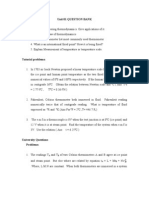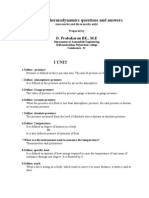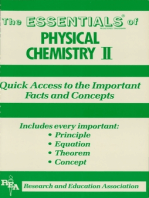Assignment-1 3rdME B
Uploaded by
Shailesh PatraAssignment-1 3rdME B
Uploaded by
Shailesh PatraBasic Thermodynamics
Assignment-1
3rd Semester ME-B
1.Define PMM-1.
2.Define thermodynamic equilibrium.
3.What is the difference between path functions and point functions? State with
examples.
4.State the first law of thermodynamics for a closed system undergoing a cycle.
5.What is the difference between an adiabatic and an isentropic process? Are all
adiabatic processes isentropic?
6.What do you mean by quasi-static process?
7. State the disadvantages of 1st law of thermodynamics?
8. Prove that PdV = Cp dT-Vdp- CvdT
9. Prove that Cp-Cv = R
10. Work done by a system follows V= 150/P m3,where p is in bar. Compute work done
on or by the system as pressure increases to 15 to 120bar.Also indicate whether it is a
compression process or expansion process.
11. A system of volume V contains a mass of gas at pressure p and temperature T. The
macroscopic properties of the system obey the following relationship:
(P+ a/V2 ) (V-b) = mRT where a, b and R are constants.
Obtain an expression for the displacement work done by the system during a
constant temperature expansion from volume V1 to Volume V2.Calculate the work
done by a system which contains 10kg of this gas expanding from 1m3 to 10m3 at a
temperature of 293K.Use the values a = 15.7x10Nm 4, b=1.07x10-2 m3 and R= 0.278
KJ/kg-K.
12. 0.085m3 drum contains saturated water and water vapour at 334ᵒC. Find the mass if
each of their volumes are equal.
13. Find the internal energy of vapour at 10bar and x = 0.95 in a vessel of 0.03m 3
capacity. Due to heat loss by radiation, the pressure of the steam falls to
3bar.Determine the quality of steam in the final state and the heat loss to radiation.
Neglect the volume of water present.
14. 80kJ of heat are supplied to a system at constant volume. The system rejects 85KJ of
heat at constant pressure and 15KJ of work is said to be done on it. The above two
processes are then followed by adiabatic process to complete the cycle. Find
adiabatic work and internal energy at all end states if initial value is 90KJ.
15. During a process of heat transfer per degree increase of temperature follows 3KJ/ᵒC
and work transfer per degree increase of temperature follows 3-0.2tKJ/ᵒC. Calculate
change in internal energy if the temperature increases from 100ᵒC to 200ᵒC.
You might also like
- Open Thermodynamics & Thermochemistry EX-1No ratings yetOpen Thermodynamics & Thermochemistry EX-113 pages
- FIRST LAW OF THERMODYNAMICS PROBLEMS PKNagNo ratings yetFIRST LAW OF THERMODYNAMICS PROBLEMS PKNag3 pages
- Thermodynamics I LAW: Part - I: Subjective QuestionsNo ratings yetThermodynamics I LAW: Part - I: Subjective Questions13 pages
- Me 6301 - Engineering Thermodynamics Unit Test 1 - Set 1No ratings yetMe 6301 - Engineering Thermodynamics Unit Test 1 - Set 12 pages
- LECTURE 26 (NOTE) - Module 13 - ThermodynamicsNo ratings yetLECTURE 26 (NOTE) - Module 13 - Thermodynamics7 pages
- Thermodynamics Qp With Solutions_watermark-1No ratings yetThermodynamics Qp With Solutions_watermark-112 pages
- Flow Work and The Energy of A Flowing FluidNo ratings yetFlow Work and The Energy of A Flowing Fluid22 pages
- “Foundations to Flight: Mastering Physics from Curiosity to Confidence: Cipher 4”: “Foundations to Flight: Mastering Physics from Curiosity to Confidence, #4From Everand“Foundations to Flight: Mastering Physics from Curiosity to Confidence: Cipher 4”: “Foundations to Flight: Mastering Physics from Curiosity to Confidence, #45/5 (1)



























































